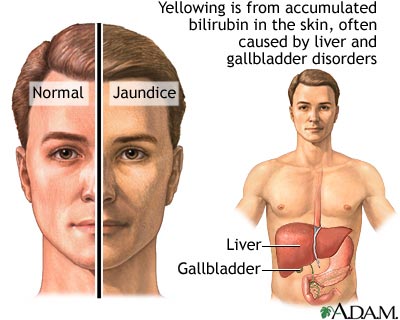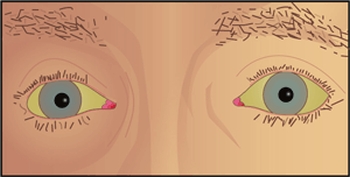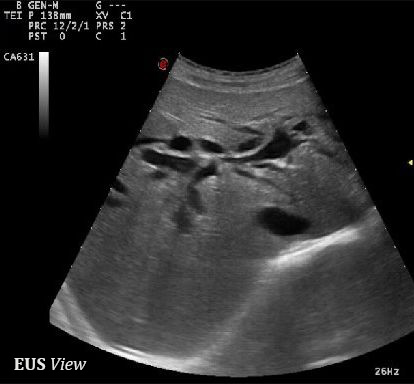Jaundice
What is Jaundice?
Jaundice is a yellow discoloration of the skin, mucous membranes, and the whites of the eyes caused by increased amounts of bilirubin in the blood. Jaundice is a sign of an underlying disease process.
Bilirubin is a by-product of the daily natural breakdown and destruction of red blood cells in the body. The hemoglobin molecule that is released into the blood by this process is split, with the heme portion undergoing a chemical conversion to bilirubin. Normally, the liver metabolizes and excretes the bilirubin in the form of bile. However, if there is a disruption in this normal metabolism and/or production of bilirubin, jaundice may result.
Jaundice Causes
Jaundice may be caused by several different disease processes. It is helpful to understand the different causes of jaundice by identifying the problems that disrupt the normal bilirubin metabolism and/or excretion.
Pre-hepatic (before bile is made in the liver)
Jaundice in these cases is caused by rapid increase in the breakdown and destruction of the red blood cells (hemolysis), overwhelming the liver's ability to adequately remove the increased levels of bilirubin from the blood.
Examples of conditions with increased breakdown of red blood cells include:
 - malaria,
- malaria,
- sickle cell crisis,
- spherocytosis,
- thalassemia,
- glucose-6-phosphate dehydrogenase deficiency (G6PD),
- drugs or other toxins, and
- autoimmune disorders.
Hepatic (the problem arises within the liver)
Jaundice in these cases is caused by the liver's inability to properly metabolize and excrete bilirubin. Examples include:
- hepatitis (commonly viral or alcohol related),
- cirrhosis,
- drugs or other toxins,
- Crigler-Najjar syndrome,
- Gilbert's syndrome, and
- cancer.
Post-hepatic (after bile has been made in the liver)
Jaundice in these cases, also termed obstructive jaundice, is caused by conditions which interrupt the normal drainage of conjugated bilirubin in the form of bile from the liver into the intestines.
Causes of obstructive jaundice include:

- gallstones in the bile ducts,
- cancer (pancreatic and gallbladder/bile duct carcinoma),
- strictures of the bile ducts,
- cholangitis,
- congenital malformations,
- pancreatitis,
- parasites,
- pregnancy,
Jaundice Symptoms
Jaundice is a sign of an underlying disease process.
Common signs and symptoms seen in individuals with jaundice include:
- yellow discoloration of the skin, mucous membranes, and the whites of the eyes,
- light-colored stools,
- dark-colored urine, and
- itching of the skin.
The underlying disease process may result in additional signs and symptoms. These may include:
- nausea and vomiting,
- abdominal pain,
- fever,
- weakness,
- loss of appetite,
- headache,
- confusion,
- swelling of the legs and abdomen, and
- newborn jaundice.
In newborns, as the bilirubin level rises, jaundice will typically progress from the head to the trunk, and then to the hands and feet. Additional signs and symptoms that may be seen in the newborn include:
- poor feeding,
- lethargy,
- changes in muscle tone,
- high-pitched crying, and
- seizures.
Exams and Tests
The health care pracitioner will need to take a detailed history of the patient's illness, and he or she will also be examined to see if there are any findings that indicate the cause of the patient's jaundice. However, additional testing is usually required to clearly determine the underlying cause of jaundice.
The following tests and imaging studies may be obtained:
Blood tests
These may initially include a complete blood count (CBC), liver function tests (including a bilirubin level), lipase/amylase level to detect inflammation of the pancreas (pancreatitis), and an electrolytes panel. In women, a pregnancy test may be obtained. Additional blood tests may be required depending upon the initial results and the history provided to the practitioner.
Urinalysis: Urinalysis is an analysis of the urine and is a very useful test in the diagnosis of screening many diseases.
Imaging Studies
- Ultrasound: This is a safe, painless imaging study that uses sound waves to examine the liver, gallbladder, and pancreas. It is very useful for detecting gallstones and dilated bile ducts. It can also detect abnormalities of the liver and the pancreas.
- Computerized tomography (CT) scan: A CT scan is imaging study similar to an X-ray that provides more details of all the abdominal organs. Though not as good as ultrasound at detecting gallstones, it can identify various other abnormalities of the liver, pancreas, and other abdominal organs as well.
- Cholescintigraphy (HIDA scan): A HIDA scan is an imaging study that uses a radioactive substance to evaluate the gallbladder and the bile ducts.
- Magnetic resonance imaging (MRI): MRI is an imaging study that uses a magnetic field to examine the organs of the abdomen. It can be useful for detailed imaging of the bile ducts.
- Endoscopic retrograde cholangiopancreatography (ERCP): ERCP is a procedure that involves the introduction of an endoscope (a tube with a camera at the end) through the mouth and into the small intestine. A dye is then injected into the bile ducts while X-rays are taken. It can be useful for identifying stones, tumors, or narrowing of the bile ducts.

- Endoscopic ultrasounds EUS: is a minimally invasive procedure with a procedural risk identical to that of gastroscopy (OGD) with low morbidity . The close proximity of the echoendoscope to the extra hepatic bile ductal system, lack of radiation and safety makes EUS an excellent method for examining the common bile duct and gallbladder such that small stones, biliary sludge, and even micro-lithiasis can be demonstrated.
- Liver Biopsy
- Percutaneous:In this procedure, a needle is inserted into the liver after a local anesthetic has been administered. Often ultrasound will be used to guide placement of the needle. The small sample of liver tissue which is obtained is sent to a laboratory for examination by a pathologist (a physician who specializes in diagnosis of tissue samples). Among other things, a liver biopsy can be useful for diagnosing inflammation of the liver, cirrhosis, and cancer.
- Another away t to take liver biopsy is during EUS-FNA which is a powerful, reliable, and safe procedure for the diagnosis of malignant liver lesions.
However, both methods are complimentary to each other.
Jaundice Treatment
Treatment depends on the cause of the underlying condition leading to jaundice and any potential complications related to it. Once a diagnosis is made, treatment can then be directed to address that particular condition, and it may or may not require hospitalization.
- Treatment may consist of expectant management (watchful waiting) at home with rest.
- Medical treatment with intravenous fluids, medications, antibiotics, or blood transfusions may be required.
- If a drug/toxin is the cause, these must be discontinued.
- In certain cases of newborn jaundice, exposing the baby to special colored lights (phototherapy) or exchange blood transfusions may be required to decrease elevated bilirubin levels.
- Surgical treatment may be required.
Self-Care at Home
The objectives of home therapy include symptom relief and managing the medical condition causing the underlying jaundice. The various measures that may be undertaken include:
- Maintain adequate hydration by drinking fluids, and rest as needed.
- Take medications only as instructed and prescribed by a health care practitioner.
- Avoid medications, herbs, or supplements which may cause detrimental side effects. Consult a health care practitioner for advice.
- Avoid drinking alcohol until the patient has discussed it with their health care practitioner.
- Certain dietary restrictions may be recommended by a health care practitioner.
- In certain cases of newborn jaundice, the parents or caregivers can place the baby next to a well lit window a few times a day to decrease elevated bilirubin levels. In more severe cases, a health care practitioner may need to discharge the baby home from the hospital with home phototherapy.
- Provide adequate milk intake for the baby in cases of breastfeeding jaundice.
- If symptoms worsen or if any new symptoms arise, consult a health care practitioner.
Medical Treatment
Treatment varies based on the medical condition responsible for causing jaundice, and the associated symptoms and complications.
Treatments may include the following:
- supportive care,
- IV fluids in cases of dehydration,
- medications for nausea/vomiting and pain,
- antibiotics,
- antiviral medications,
- blood transfusions,
- steroids,
- chemotherapy/radiation therapy, and
- phototherapy (newborns).
Medications
Medications may or may not be necessary. After diagnosing the cause of the patient's jaundice, the health care practitioner will direct the patient's treatment and prescribe medications if they are necessary. As outlined above, various medication options exist depending on the underlying cause of the jaundice.
Surgery
Surgical treatment may be necessary in certain cases of cancer, congenital malformations, conditions that obstruct the bile ducts, gallstones, and abnormalities of the spleen. Sometimes, a liver transplant may be necessary.
Prevention
The underlying medical condition causing jaundice can in some cases be prevented. Some preventive measures include the following:
- Avoid heavy alcohol use (alcoholic hepatitis, cirrhosis, and pancreatitis).
- Vaccines for hepatitis (hepatitis A, hepatitis B)
- Take medications which prevent malaria before travelling to high-risk regions.
- Avoid high-risk behaviors such as intravenous drug use or unprotected intercourse (hepatitis B).
- Avoid potentially contaminated food/water and maintain good hygiene (hepatitis A).
- Avoid medications that can cause hemolysis in susceptible individuals (such as those with G6PD deficiency, a condition that leads to red blood cell breakdown after consumption of certain substances).
- Avoid medications and toxins which can cause hemolysis or directly damage the liver.
Outlook
The prognosis depends on the underlying cause. Some conditions are easily managed and carry an excellent prognosis, while others may become chronic and require lifelong physician supervision. Unfortunately, some conditions causing jaundice may be fatal despite medical or surgical intervention. Discuss the prognosis with a health care practitioner once a diagnosis has been established.

